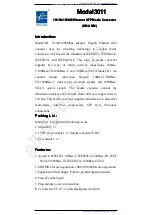
SECTION 8 |
Installation
39
8.8 ON/OFF CONTROL FROM REMOTE LOCATION USING 2-WIRE OR
1-WIRE EXTERNAL ON/OFF CONTROL
CAUTION!
For operation of this function, the 3-Position Rocker Switch on the front
!
panel marked “ON/OFF/EXT. Switch (1, fig 6.1a) should be FIRST pushed
at the bottom end (marked “=”) to rock it to the bottom “EXT. Switch”
position.
The unit can be switched ON/OFF from a remote location using external, wired ON/
OFF control arrangements as shown in fig 8.2(a), (b) and (c). Details are given below:
• 2-Wire ON/OFF Control from Remote Location Using Switch/Relay Contact, Fig
8.2(a): In this arrangement, external voltage source is NOT required. The inverter
will switch ON when the relay contact / switch is closed and terminals 1 and 2 of
the Terminal Block (10, fig 6.1a) are shorted. The inverter will switch OFF when the
relay contact / switch is opened and short is removed across terminals 1 and 2 of
the Terminal Block (10, fig 6.1a).
• 2-Wire ON/OFF control Using Switched DC Voltage (10-33VDC), fig 8.2(b):
CAUTION!
1. Please ensure correct polarity of wiring connection. Positive (+) of the
!
external DC source should be connected to Terminal 3 of the Terminal
Block (10, fig 6.1a) and Negative (-) to Terminal 4. In case the polarity
is reversed, the ON/OFF control will NOT operate. The input to these
terminals is protected against reverse polarity
2. Use 1A fuse as shown as close to the DC source as possible
INFO
The 10-33VDC external control signal on terminals 3 and 4 of the Terminal
i
Block (10, fig 6.1a) feeds to an internal Opto-Isolator. Hence, the Negative
Ground of the external 10-33VDC source can be isolated from the Negative
Ground of the Battery input to the inverter.
The inverter will switch ON when the external relay contact / switch is closed
[External DC voltage (10-33VDC) is fed to terminals 3 and 4 of the Terminal Block
(10, fig 6.1a)]. The inverter will switch OFF when the external relay contact / switch
is opened [External DC voltage (10-33VDC) is removed from terminals 3 and 4 of the
Terminal Block (10, fig 6.1a)].














































